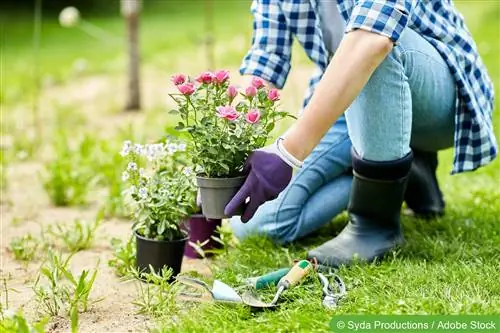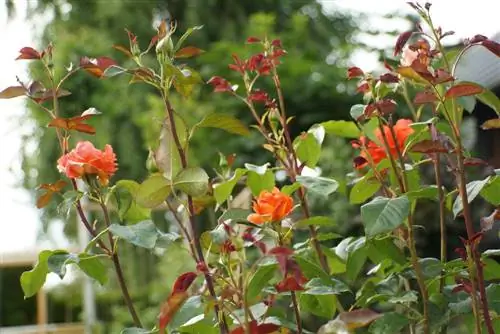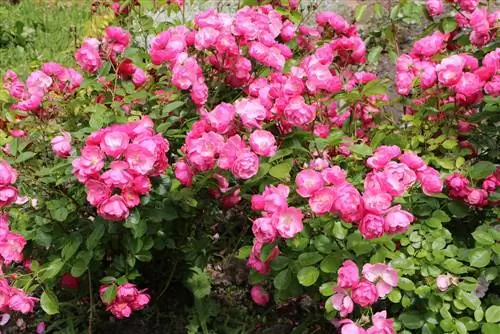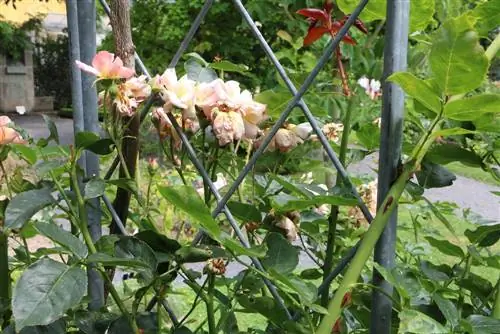- Author admin [email protected].
- Public 2023-12-17 03:39.
- Last modified 2025-06-01 06:48.
Roses are one of the most popular plants in the home garden. Since most varieties bloom all summer long, you can enjoy the beautiful sight for a long time. In addition, you get a wonderful scent in the garden - thanks to the rose petals.
The roses still require special care so that they can radiate their unique charm. In addition to planting and transplanting correctly, perfect pruning is also very important. Good care is essential so that you can enjoy the roses for a long time.
Choosing the right location for roses
Since many mistakes can be made when planting a rose, you should work precisely and carefully here. This is the only way you will enjoy the roses in your garden for a long time. The right location is very important. A sunny location is ideal as a location. Loamy soil is best and needs to be loosened to improve root growth. If roses have already stood there, replacing the soil is essential, as the roses need humus-rich and nutritious soil.
Dig and process the planting hole
The roses should be planted from the end of October to the end of April at the latest. However, roses should not be planted during the frosty season. The hole that is dug should be sufficiently deep and wide so that the spread roots fit well and have enough space. A planting hole is ideal if it is 40 cm deep and wide. The excavated soil can be loosened with peat or special rose soil. To ensure that the rose roots are better ventilated, it makes sense to mix two hands of lava stones into the excavated soil per planting hole. If the soil is very sandy, the water holding capacity should be improved with bentonite or soil granules. Compost and fertilizer must be avoided as these would burn the fine roots. 3-4 roses are sufficient per square meter; these should be planted at a minimum distance of 30-50 cm.
Cutting roses and protecting them from the weather
Before the roses can be planted, they must be trimmed. The shoots and roots should be shortened to 20 cm from the grafting point. The grafting point is the connection point between root and shoot. This distribution point must be approximately 5 cm below the surface of the earth. Place the roots straight into the planting hole and fill it with the soil mixture that you previously worked on. The soil around the rose should only be pressed with your hands so that the soil does not become too compacted. So that the soil can settle between the roots, it must be watered sufficiently. Once the soil has settled, you need to use the remaining soil to make a mound about 10 cm high. This means that only 5 cm of the rose is visible. The mound offers the rose protection from frost in winter and in spring it offers protection from wind and sun.
Transplanting roses
- When transplanting roses, you have to pay attention to a few important things, as old and large roses in particular have problems growing again.
- The roses should only be transplanted if there is no other option to maintain their current location.
- Before the shoots sprout in spring, you should transplant. Autumn is also ideal for this. Summer and winter are not suitable..
- The roses must be cut back before they are dug up. In autumn you can prune roses radically, but in spring fewer shoots need to be pruned.
- The roots are loosened using a spade. The ball of soil you dig must correspond to the width of the entire roses.
Use growing aids for the roses
The hole in the ground at the new location must be dug larger than at the old location. It is ideal to add compost to the new planting hole and water it beforehand. This helps improve the soil and helps the rose grow. Now the roses can move into their new planting hole. Care must be taken to ensure that the roses are now deeper than in the old planting hole. This makes it easier for the roses to grow.
Now the planting holes must be filled with soil and then lightly tamped down. A watering hole must be created around the rose. The rose must then be watered thoroughly so that the roots come into contact with the soil. In the following days it is important that the roses are always provided with enough water. Transplanting can cause the roses to grow wild, long shoots. These can be cut off even if the flower will suffer. The rose will shine again in all its splendor a year later.
Fertilizing and watering
You should avoid fertilizer for a year after planting. Fertilizer is only allowed for transplanted roses in the first year. Make sure that the roses are always watered sufficiently. In the summer months it is advisable to water in the morning so that the plant has moisture throughout the day.
Detect diseases early on
Roses tend to become vulnerable, especially when the weather changes dramatically. As soon as rust, mildew or sooty mold develops, you must treat it with a suitable pesticide. If you are not sure what disease your rose has, take a leaf with you to the garden store. You will receive comprehensive advice there. Do not wait until the entire plant is affected, usually pesticides will no longer help and the rose will be destroyed forever.
Roses overwinter safely
In winter it is important to protect the finishing area from cold and wind. Tilting is the safest method, but if this is not possible, the crown must be filled with leaves and straw. These are then tied tightly with fir branches and packed with a jute sack. But be careful, never use foil that causes condensation.
Planting roses - useful information in brief
- If you want to plant roses in the garden, you should put them in a bucket of water after buying them so that they can soak up.
- The above-ground shoots should then be shortened to a length of 20 cm.
- If the roses are bare root, the roots should also be shortened to a length of 20 cm.
- Finally, you should dig a sufficiently deep planting hole and loosen the bottom of the hole accordingly.
- The excavated soil should finally be enriched with humus, lime and rose fertilizer. In this way you give the roses the best possible development.
- If you want to plant the roses correctly, you should also make sure that the grafting point is about 5 cm below the surface of the soil.
- For roses that have been sitting in pots, you should also make sure that the roots are as deep as they were before in the pot.
- Finally, you should fill up the soil, press it down well and finally water the rose. The best way to press the soil is to trample it firmly.
- Roses should be piled up to a height of around 20 cm after planting. If you plant the rose in spring, you should dig it down again after about three weeks when the weather is as cloudy as possible.
If you want to plant roses correctly, you should pay close attention to what demands they place on the location. Roses don't like waterlogging. It is therefore important to loosen the base of the planting hole as much as possible so that excess water can drain into the ground even when it rains. The location of the roses should also be airy and sunny. In addition, these beautiful plants do not like drafts. If the location is chosen correctly, the foliage can dry well and the plant is not immune to fungal diseases. This reduces the risk of illness. Just like waterlogging, roses don't like standing heat or soil that is too dry.
- In order for roses to develop optimally, they need a loamy, sandy soil with a high humus content.
- Since roses are deep-rooted, their roots can reach up to a meter deep.
- The pH value of the soil should also be between 6.5 and 7.5.






